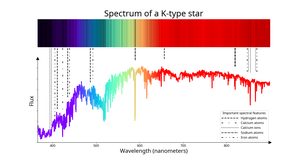Glossarbegriffe: K-Stern
Description: Ein Stern der Spektralklasse "K". Astronomen erkennen K-Sterne daran, dass ihre Spektren sehr schwache Wasserstofflinien, aber starke Linien von Eisen- und Manganatomen aufweisen. Sie haben typische (effektive) Temperaturen zwischen etwa 3700 Kelvin (K) und 5200 K. Im Vergleich zu anderen Sternen erscheinen sie dem menschlichen Auge orange-weiß, es sei denn, Effekte von interstellarer oder atmosphärischer Extinktion spielen eine Rolle. Beispiele für Sterne vom Typ K sind Aldebaran im Sternbild Stier und Pollux im Sternbild Zwillinge.
Zugehörige Glossarbegriffe:
See this term in other languages
Term and definition status: The original definition of this term in English have been approved by a research astronomer and a teacher The translation of this term and its definition is still awaiting approval
The OAE Multilingual Glossary is a project of the IAU Office of Astronomy for Education (OAE) in collaboration with the IAU Office of Astronomy Outreach (OAO). The terms and definitions were chosen, written and reviewed by a collective effort from the OAE, the OAE Centers and Nodes, the OAE National Astronomy Education Coordinators (NAECs) and other volunteers. You can find a full list of credits here. All glossary terms and their definitions are released under a Creative Commons CC BY-4.0 license and should be credited to "IAU OAE".
If you notice a factual or translation error in this glossary term or definition then please get in touch.
Related Diagrams
Spectrum of a K-type star
Bildnachweis: IAU OAE/SDSS/Niall Deacon
License: CC-BY-4.0 Creative Commons Namensnennung 4.0 International (CC BY 4.0) icons









